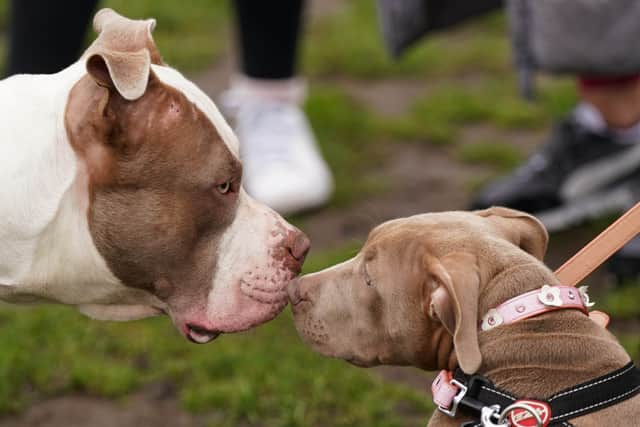What is the Calgary Model? Petition calling for alternative to XL bully ban gains momentum
and live on Freeview channel 276
A petition calling for a new approach to animal control that's been shown to reduce dog bites has been signed by more than 35,000 people and counting - as an alternative to the impending XL bully ban.
The government last month announced American XL bullies - a relatively new dog breed descended, in part, from pit bulls - would officially be added as a banned breed under the Dangerous Dogs Act on December 31. This will make it illegal to breed, sell, advertise, exchange, rehome, abandon or adopt out XL bully dogs in England and Wales, and owners will have until the beginning of February to either put their dog down - or pay for a special exemption, keeping them muzzled while off their property.
Advertisement
Hide AdAdvertisement
Hide AdMPs first took aim at American XL bullies in late September. Prime Minister Rishi Sunak announced the breed would be banned by the end of the year, on the back of two serious attacks involving the breed - one where a young Birmingham girl and two men who tried to help her were bitten, and the death of Staffordshire man Ian Price, who died of his injuries after trying to defend his elderly mother from two loose XL bullies.
The Change.org petition, created by dog rescue operator Billy Rumsey, advocates for adopting the 'Calgary Model' - an education-based approach which has seen some success overseas. "As a dog trainer, behaviourist, and rescue operator, I have seen first-hand the panic and confusion caused by the impending XL bully ban," he wrote. "In just three days, I have rescued 27 abandoned pups - innocent victims of a system that is failing them. Instead of resorting to what amounts to a breed cull - an approach proven time and again not to work - we need to consider successful alternatives."


He claimed the model had led to significant reductions in aggressive incidents involving dogs, citing data from the City of Calgary's Animal & Bylaw Services - which found a 15% decrease in aggressive dog incidents within five years of implementation.
"We must push for policies that prioritize education over eradication, love over fear, understanding over ignorance," Mr Rumsey added. "Let's advocate for the implementation of the Calgary Model as an alternative solution instead of resorting to ineffective bans that only result in more abandoned pups like those I've recently rescued."
Advertisement
Hide AdAdvertisement
Hide AdThis comes amid reports some pounds are euthanising as many as eight stray or abandoned dogs a day - the majority thought to be XL bullies. The BBC has spoken to dozens of dog experts, including charity workers and vets, who say abandonments spiked after the ban was announced. On top of this, one East England vet told the broadcaster that their practice alone was putting down around 15 XL bullies each week.
What does the Calgary Model involve?
The Calgary Model originated in the Canadian city of the same name, and involves an approach to animal control that has seen huge success - including low rates of euthanasia, and high return-to-owner and bylaw compliance rates.
The city's former Director of Animal Services and Bylaws Bill Bruce is credited with its development. Under his leadership, the city took a collaborative approach. "We brought everyone to the table... We stopped the fighting between the organizations,” Mr Bruce said in a past interview. They invited vets, rescue organisations, trainers, dog and cat breeders, and behaviourists to help develop the program, with many still involved as stakeholders to this day.
Secondly came a widespread public information campaign, with everything from collaborative events in parks and city venues for owners and communities, to a school program to educate young people about responsible pet ownership. This included a focus on proper licencing and registration; neutering pets; proper training, socialisation, diets, and healthcare; and getting pets from ethical sources.
Advertisement
Hide AdAdvertisement
Hide AdThe city then developed an animal services department with that proactively provides services like reuniting pets with their owners, spaying and neutering, and even emergency medical care. Compassion and accepting pets as a part of the community was also vital, local animal welfare organisation Keep Cats Safe and Save Bird Lives wrote.
Animal control staff were specially trained in community relations and conflict resolution, while the department had the power to waive license fees for low-income residents. Calgary firefighters were all trained in pet CPR, and carried pet-sized oxygen masks, and if Calgary police go to a domestic abuse scene and one partner needs to leave - the police will take their pets to a shelter, where they will be fostered until they can be reunited.
Comment Guidelines
National World encourages reader discussion on our stories. User feedback, insights and back-and-forth exchanges add a rich layer of context to reporting. Please review our Community Guidelines before commenting.
